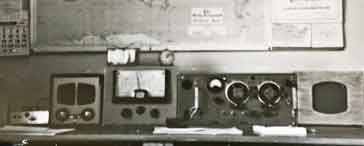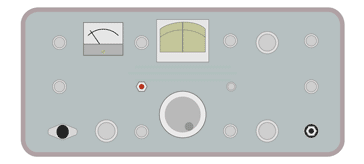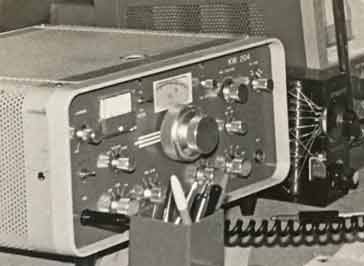KW Electronics
KW Electronics was a UK manufacturer of transmitters, receivers, transceiver and other radio communications equipment for the amateur radio / ham radio market.
KW Amateur Radio Equipment Includes:
KW Electronics
KW-Geloso Front End Converter
KW2000 transceiver
KW204 transmitter
Iconic radio receivers:
Summary of iconic radio receivers
Radio receiver history
Crystal radio sets
Development of the superhet radio
Radio history / timeline
KW Electronics started as the need for radio communications equipment designed for the amateur radio or ham radio market started to emerge in the early 1950s.
After World War II, a lot of surplus equipment had come onto the market, and this formed the mainstay for most amateur radio stations. However there was a growing need for some items of equipment that needed to be designed for the ham radio bands - antennas and other ancillary items which were not available as surplus items.
Later, in the late 1950s there was a need for HF single sideband equipment as this mode was being used increasingly.
KW saw the need and the market for them and grew as a company as the needs changed and grew.
Today, KW equipment is well sought after and there are many vintage radio enthusiasts and radio amateurs who collect and renovate this equipment.
Beginnings of KW Electronics
KW Electronics was founded in the early 1950s by Rowley Shears, G8KW and Ken Ellis, G5KW. The common factor of their ham radio callsigns giving rise to the name.
Initially the company manufactured antennas - the G8KW trap dipole antenna had many close similarities to the W3DZZ. It covered the 80 to 10 metre bands of the day and the centre and outer of the coax could be strapped together and tuned against ground for operation on 160 metres. The antenna sold well and it set the foundations for a variety of other developments and products.
In addition to the antenna, they sold a variety of other equipment including Geloso equipment from an Italian manufacturer. A relationship built up and they developed a transmitter called the KW Vanguard. This was launched in 1957
The vanguard was an AM / CW transmitter that used a Geloso VFO unit as the basis for the signal generation, and around this they set the buffer amplifiers, a 6146 power amplifier and the audio line up concluding with 2 x 6L2 and a modulation transformer for AM.
A variant of the Vanguard was called the KW Valiant, and this was aimed at the mobile market, although it still provided a good base station transmitter at the time, but needed an external power supply.
Another interesting item of KW equipment that is rarely seen tis an amateur band converter. Essentially this used a radio, possibly a government surplus radio tuned to the IF of the converter. The KW / Geloso converter provided the RF, mixer and VFO local oscillator with the output fed into the receiver. In this way it provided additional gain that was often needed as well as band-spread coverage, possible improved frequency stability, and a much better overall user experience. The converter used a Geloso RF unit for all the RF sections, and then KW added the power supply, and case.

(The 19set had the transmitter disabled so there was no chance of putting tranmitter power into the output of the receive converter)
KW Electronics continued to sell a variety of products for some while. An advertisement in the Short Wave Magazine from 1963 shows them selling items like: CDR antenna rotators, TOKAI 28.5 Mc/s walkie talkies, coax cable, polythene cord for antennas and many more items.
The company continued to focus on the manufacture of separate receivers and transmitters, as this had been the general approach. However things were about to change.
KW2000 years
In 1959, Collins Radio launched their KWM2. This was a successor to their KWM1 which had been introduced a year or so earlier.
The KWM2 was demonstrated at the RSGB Radio Communications Exhibition in 1959 and it set out a new direction for amateur radio communications equipment. It was designed to be able to be operated in a mobile environment as well as providing excellent base station operation. The KWM2 was an amateur bands only HF transceiver with an external power supply. It was capable of delivering around 100 watts PEP to the antenna and had all the controls that were necessary, but it was easy to use.
KW saw this and knew they needed to compete with this to be able to stay in the business. They also knew they needed to provide it at a price that UK radio amateurs could afford - the KWM2 was very expensive.
KW Electronics set about developing their new transceiver. It was contained within a single manageable desktop case that had a rounded sleeve, and sufficient controls were provided to allow easy operation.
The set had a single 6146 in the output and this gave it only half the power capability of the KWM2, but it was sufficient to get many radio amateurs on the air, and the KW2000 was a great success.

There were several innovative aspects to the design. Collins had used their own mechanical filter to provide the selectivity needed for SSB transmitter and receiver filtering. KW used a Kokusai mechanical filter. Also many of the coils needed were wound directly onto dust iron cores and the required tap selected for different bands. Cost was obviously a major issue, but so was performance so several measures were needed to provide the best solution.
The KW2000 was a great success and the company needed to produce as many of them as they could. They even had a request for a version of the set for commercial two way radio communications.
KW Electronics did not want to stand still, and before too long, the next update to the KW2000 was launched. designated the KW2000A, its main update was that of a higher power output stage capable of delivering around 100W PEP output form a DC input of 180W PEP. This brought many further sales and established KW Electronics as a major amateur radio equipment supplier globally, although comparatively few sales were made in the US because oft he competition there.
Ultimately a number of variants of the KW2000 were made, of which the most notable os the KW2000B which had new "G-Line" styling and a number of other refinements.
Other lines for KW Electronics
Although the KW2000 was the main product for KW Electronics, they still manufactured a number of other pieces of equipment.
Items like the KW EZEE Match, G8KW antenna, remained very popular. However they also continued to separate transmitters and receivers. initially the KW201 receiver and KW Vespa were sold. These were launched in the mid 1960s. These borrowed much from the KW2000 in terms of technology. However the Vespa Mk1 used a 6146 but later this was upgraded in 1967 to the Mk II which used a 6HF5 or 6LQ6 as the output valve to give it a power capability of 220 watts PEP DC input on SSB and 150 watts input on CW. These tubes were able to handle the power for only short periods and it they tended to need replacing on a regular basis if they were "talked up" too much.
Later these two separates were updated with the KW202 receiver and KW204 transmitter. This time the KW204 used two 6146s in the final amplifier to give a much more robust and reliable unit.

Needing to compete with competition from the USA again, KW launched their Atlanta. This aimed at the same market that the Swan 500 was aiming to catch, and indeed the KW Atlanta had very many similarities. Having a final input power of 500 watts PEP it certainly packed a punch.
Japanese competition and take-over
As the 1960s drew to a close, Japanese ham radio equipment started to land on the shores of the UK. Equipment like the Trio (now Kenwood) TS500 offered excellent performance and at a lower cost.
In 1974 the company was sold to Decca which was more interested in the commercial radios produced by Decca and with growing competition, the amateur radio arm was significantly cut back, although a catalogue was produced as late as 1977.
In 1980, Decca, in turn was sold to Racal and soon the KW name was dropped.
Rowley Shears did manage to buy back the KW Electronics name and he continued to trade for a number of years selling KW ancillaries and TEN TEC equipment. The manufacture of transmitters, receivers and transceivers was no longer viable with competition from the Far East.
With the retirement of Rowley Shears in 1989, KW ceased trading and the company became dormant. In recent years the name has been resurrected so the name of KW Electronics is still active, if even in a much smaller way.
Summary of main KW Electronics products
During its lifetime, KW Electronics made a wide variety of products, manly for the amateur radio market. Although they are probably best known for their KW2000 transceiver, they made a number of separate transmitters and receivers as well as antennas, antenna matches, SWR meters and the like.
The list below gives details soem of the main products that the company made in its lifetime.
| List of the Main KW Vintage Radios, Transceivers, & other Equipment for Amateur Radio |
||
|---|---|---|
| Equipment Number | Description | |
| G8KW antenna | This was a trapped antenna for the HF bands which could be made to operate on 160, 80, 40, 20, 15, & 10 metre bands. It was very similar in design to the W3DZZ. | |
| G8KW EZEE Match | This was always a popular addition to any radio amateur's station. It performed reliably and was able to cover 3.5 - 30 Mc/s, resistive loads between 15 & 5000Ω and it could handle 400 watts PEP SSB, or 100 watts AM. | |
| G8KW / Geloso Converter | In the late 1950s, the concept of using a converter like this for amateur band reception with the converter feeding into a receiver such as a government surplus set tuned to the fixed frequency of the converter. This provided improved performance over that which the government surplus could provide. KW used the RF sections from an Italian company called Geloso for the RF sections, adding the power supply, case, etc. | Read more |
| KW Vanguard transmitter | This was a base station, HF AM/CW transmitter. It was designed around the Italian Geloso VFO unit, covering 80 - 10m. AM was provided using two 6L6 valves to plate modulate the single 6146 used as the RF power amplifier. An option was available at purchase to enable it to cover the 160 metre band. | |
| KW Valiant transmitter | This was effectively a mobile version of the Vanguard. It contained all the circuitry of the Vanguard but without the power supply and was able to provide AM and CW operation from 80 - 10 metres with an option for it to also cover 160 metres. | |
| KW Viscount | This was the first single sideband transmitter from KW Electronics and it was introduced in 1958. Sadly it used the phasing method of generating SSB, and was not as successful as had been hoped. It was succeeded shortly afterwards by the KW Viceroy. | |
| KW Viceroy | This was a single sideband transmitter. It succeeded the Viceroy and used the filter method for generating SSB. IT was far more succesful than its predecessor. | |
| KW Vespa | The KW Vespa was launched after the KW2000 series. IT fitted ina similar compact case to that of the 2000, but used a television line output valve as the final amplifier. These tended to fail very easily if pushed too hard. | |
| KW76 receiver | This was KW's first entry into the HF radio market | |
| KW77 receiver | This was a development of the KW76 HF receiver | |
| KW103 SWR Meter | The KW103 was an SWR meter styled to match the KW2000B | |
| KW108 Monitor Scope | In the early days of SSB, and up until the 1970s, it was considered to be good practice to use a scope to check the output waveform. This monitor scope fulfilled this function, being tailored to monitor SSB waveforms being transmitted. | |
| KW109 Supermatch | This was an high power version of the KW107. | |
| KW110 Q multipler | Q multipliers were used to connect to the IF of a receiver to improve the Q of the IF stages to improve the Q of the inductors and thereby improve the selectivity | |
| KW160 transmitter | This was a relatively small transmitter providing 10 watts of AM / CW for use on the 160 metre band covering 1.8 - 2.0 Mc/s. | |
| KW201 Receiver | This receiver took many aspects of the KW2000 to provide a receiver, often intended as a companion for the KW Vespa transmitter. | |
| KW202 Receiver | This was an update to the KW201, intended as a companion to the KW204 transmitter, although full transceive was not possible when the two were used together. | |
| KW204 Transmitter | This was an update to the KW201, intended as a companion to the KW204 transmitter, although full transceive was not possible when the two were used together. | Read more |
| KW600 linear amplifier | Designed primarily for operation with KW equipment, although they would easily operate with others, the KW600 used a single 572B output valve in ground grid configuration to run at 500 watts PEP DC input from just 20 watts fromt he driving device. | |
| KW1000 linear amplifier | This was the big brother of the KW600, and was contained within a G-line style case. It produced an output of up to 600 watts PEP from around 50 - 75 watts of drive. It used a pair of 572B valves. | |
| KW2000 | This was KW's most successful product and was manufactured for over ten years and with a number of variants and updates along the way: KW2000, KW2000A, KW2000B, etc .. It was an HF band amateur radio transceiver, although some variants were produced for commercial use. It was a truly iconic vintage radio. | Read more |
| KW Atlanta | This was an HF all band (for the time) HF transceiver that seemed to be aimed at competing with US equivalents like the Swan 500C, etc. Introduced around 1969, it used two 6LQ6 valves in the output, but these TV line output valves did not like being over-driven. | |
KW Electronics was active for over 20 years from its foundation until after it was taken over by Decca. During its time of operation it made a huge number of radio communications associated products for the amateur radio market and its name was known around the globe, and it was a major force in the UK market.
For many years KW Electronics and KW equipment dominated the amateur radio market in the UK and man other countries. They produced equipment that was good value for money, reliable and worked well. Today many sets are still working and used on the HF amateur radio bands. This is a testament to the design work, ingenuity, and quality put into these equipments that are now considered to be vintage radios.
 Written by Ian Poole .
Written by Ian Poole .
Experienced electronics engineer and author.
More History:
Radio history timeline
History of the radio
Ham radio history
Coherer
Crystal radio
Magnetic detector
Spark transmitter
Morse telegraph
Valve / tube history
PN junction diode invention
Transistor
Integrated circuit
Quartz crystals
Classic radios
Mobile telecoms history
Vintage mobile phones
Return to History menu . . .




